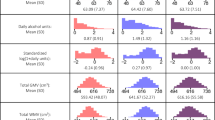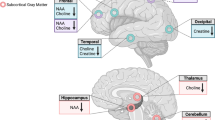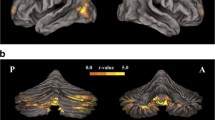Abstract
Objective
It has previously been reported that even social alcohol consumption affects the magnetic resonance spectroscopy (MRS) signals of choline-containing compounds (tCho). The purpose of this study was to investigate whether the consumption of alcohol affects the concentrations of the metabolites tCho, N-acetylaspartate, creatine, or myo-inositol and/or their T 2 relaxation times.
Materials and methods
1H MR spectra were obtained at 3 T from a frontal white matter voxel of 25 healthy subjects with social alcohol consumption (between 0 and 25.9 g/day). Absolute brain metabolite concentrations and T 2 relaxation times of metabolites were examined via MRS measurements at different echo times. Metabolite concentrations and their T 2 relaxation times were correlated with subjects’ alcohol consumption, controlling for age.
Results
We observed positive correlations of absolute tCho and phosphocreatine and creatine (tCr) concentrations with alcohol consumption but no correlation between any metabolite T 2 relaxation time and alcohol consumption.
Conclusions
This study shows that even social alcohol consumption affects the concentrations of tCho and tCr in cerebral white matter. Future studies assessing brain tCho and tCr levels should control for the confounding factor alcohol consumption.



Similar content being viewed by others
References
Meyerhoff DJ, Bode C, Nixon SJ, de Bruin EA, Bode JC, Seitz HK (2005) Health risks of chronic moderate and heavy alcohol consumption: how much is too much? Alcohol Clin Exp Res 29(7):1334–1340
Ende G, Walter S, Welzel H, Demirakca T, Wokrina T, Ruf M, Ulrich M, Diehl A, Henn FA, Mann K (2006) Alcohol consumption significantly influences the MR signal of frontal choline-containing compounds. Neuroimage 32(2):740–746
McCreadie RG (2002) Use of drugs, alcohol and tobacco by people with schizophrenia: case–control study. Br J Psychiatry 181:321–325
Margolese HC, Malchy L, Negrete JC, Tempier R, Gill K (2004) Drug and alcohol use among patients with schizophrenia and related psychoses: levels and consequences. Schizophr Res 67(2–3):157–166
Welch KA, McIntosh AM, Job DE, Whalley HC, Moorhead TW, Hall J, Owens DG, Lawrie SM, Johnstone EC (2011) The impact of substance use on brain structure in people at high risk of developing schizophrenia. Schizophr Bull 37(5):1066–1076
Weber AM, Soreni N, Noseworthy MD (2014) A preliminary study on the effects of acute ethanol ingestion on default mode network and temporal fractal properties of the brain. Magma 27(4):291–301. doi:10.1007/s10334-013-0420-5
Vollstadt-Klein S, Hermann D, Rabinstein J, Wichert S, Klein O, Ende G, Mann K (2010) Increased activation of the ACC during a spatial working memory task in alcohol-dependence versus heavy social drinking. Alcohol Clin Exp Res 34(5):771–776. doi:10.1111/j.1530-0277.2010.01149.x
Strang NM, Claus ED, Ramchandani VA, Graff-Guerrero A, Boileau I, Hendershot CS (2015) Dose-dependent effects of intravenous alcohol administration on cerebral blood flow in young adults. Psychopharmacology 232(4):733–744. doi:10.1007/s00213-014-3706-z
Vengeliene V, Bilbao A, Molander A, Spanagel R (2008) Neuropharmacology of alcohol addiction. Br J Pharmacol 154(2):299–315
Delin CR, Lee TH (1992) Drinking and the brain: current evidence. Alcohol Alcohol 27(2):117–126
Harper C, Matsumoto I (2005) Ethanol and brain damage. Curr Opin Pharmacol 5(1):73–78
Mann K, Agartz I, Harper C, Shoaf S, Rawlings RR, Momenan R, Hommer DW, Pfefferbaum A, Sullivan EV, Anton RF, Drobes DJ, George MS, Bares R, Machulla HJ, Mundle G, Reimold M, Heinz A (2001) Neuroimaging in alcoholism: ethanol and brain damage. Alcohol Clin Exp Res 25(5 Suppl ISBRA):104S–109S
Spanagel R (2009) Alcoholism: a systems approach from molecular physiology to addictive behavior. Physiol Rev 89(2):649–705
Buhler M, Mann K (2011) Alcohol and the human brain: a systematic review of different neuroimaging methods. Alcohol Clin Exp Res 35(10):1771–1793
Lee DW, Kim SY, Kim JH, Lee T, Yoo C, Nam YK, Jung JY, Shin HC, Kim HY, Kim DJ, Choe BY (2013) Quantitative assessment of neurochemical changes in a rat model of long-term alcohol consumption as detected by in vivo and ex vivo proton nuclear magnetic resonance spectroscopy. Neurochem Int 62(4):502–509. doi:10.1016/j.neuint.2013.02.007
Zahr NM, Mayer D, Rohlfing T, Hsu O, Vinco S, Orduna J, Luong R, Bell RL, Sullivan EV, Pfefferbaum A (2014) Rat strain differences in brain structure and neurochemistry in response to binge alcohol. Psychopharmacology 231(2):429–445. doi:10.1007/s00213-013-3253-z
Meyerhoff DJ, Blumenfeld R, Truran D, Lindgren J, Flenniken D, Cardenas V, Chao LL, Rothlind J, Studholme C, Weiner MW (2004) Effects of heavy drinking, binge drinking, and family history of alcoholism on regional brain metabolites. Alcohol Clin Exp Res 28(4):650–661
Jagannathan NR, Desai NG, Raghunathan P (1996) Brain metabolite changes in alcoholism: an in vivo proton magnetic resonance spectroscopy (MRS) study. Magn Reson Imaging 14(5):553–557
Ende G, Welzel H, Walter S, Weber-Fahr W, Diehl A, Hermann D, Heinz A, Mann K (2005) Monitoring the effects of chronic alcohol consumption and abstinence on brain metabolism: a longitudinal proton magnetic resonance spectroscopy study. Biol Psychiatry 58(12):974–980
Jernigan TL, Schafer K, Butters N, Cermak LS (1991) Magnetic resonance imaging of alcoholic Korsakoff patients. Neuropsychopharmacology 4(3):175–186
Pfefferbaum A, Lim KO, Zipursky RB, Mathalon DH, Rosenbloom MJ, Lane B, Ha CN, Sullivan EV (1992) Brain gray and white matter volume loss accelerates with aging in chronic alcoholics: a quantitative MRI study. Alcohol Clin Exp Res 16(6):1078–1089
Pfefferbaum A, Sullivan EV, Mathalon DH, Lim KO (1997) Frontal lobe volume loss observed with magnetic resonance imaging in older chronic alcoholics. Alcohol Clin Exp Res 21(3):521–529
Pfefferbaum A, Sullivan EV (2002) Microstructural but not macrostructural disruption of white matter in women with chronic alcoholism. Neuroimage 15(3):708–718
Rosenbloom M, Sullivan EV, Pfefferbaum A (2003) Using magnetic resonance imaging and diffusion tensor imaging to assess brain damage in alcoholics. Alcohol Res Health 27(2):146–152
Pfefferbaum A, Adalsteinsson E, Sullivan EV (2006) Supratentorial profile of white matter microstructural integrity in recovering alcoholic men and women. Biol Psychiatry 59(4):364–372
Chanraud S, Martelli C, Delain F, Kostogianni N, Douaud G, Aubin HJ, Reynaud M, Martinot JL (2007) Brain morphometry and cognitive performance in detoxified alcohol-dependents with preserved psychosocial functioning. Neuropsychopharmacology 32(2):429–438
Eckardt MJ, Martin PR (1986) Clinical assessment of cognition in alcoholism. Alcohol Clin Exp Res 10(2):123–127
Friedman SD, Shaw DW, Artru AA, Dawson G, Petropoulos H, Dager SR (2006) Gray and white matter brain chemistry in young children with autism. Arch Gen Psychiatry 63(7):786–794
Tunc-Skarka N, Weber-Fahr W, Hoerst M, Meyer-Lindenberg A, Zink M, Ende G (2009) MR spectroscopic evaluation of N-acetylaspartate’s T 2 relaxation time and concentration corroborates white matter abnormalities in schizophrenia. Neuroimage 48(3):525–531
Bracken BK, Rouse ED, Renshaw PF, Olson DP (2013) T 2 relaxation effects on apparent N-acetylaspartate concentration in proton magnetic resonance studies of schizophrenia. Psychiatry Res 213(2):142–153. doi:10.1016/j.pscychresns.2013.03.005
Schubert F, Seifert F, Elster C, Link A, Walzel M, Mientus S, Haas J, Rinneberg H (2002) Serial 1H-MRS in relapsing-remitting multiple sclerosis: effects of interferon-beta therapy on absolute metabolite concentrations. Magma 14(3):213–222
Kirov II, Liu S, Fleysher R, Fleysher L, Babb JS, Herbert J, Gonen O (2010) Brain metabolite proton T 2 mapping at 3.0 T in relapsing-remitting multiple sclerosis. Radiology 254(3):858–866. doi:10.1148/radiol.09091015
Marjanska M, Emir UE, Deelchand DK, Terpstra M (2013) Faster metabolite (1)H transverse relaxation in the elder human brain. PLoS ONE 8(10):e77572. doi:10.1371/journal.pone.0077572
Kirov II, Fleysher L, Fleysher R, Patil V, Liu S, Gonen O (2008) Age dependence of regional proton metabolites T 2 relaxation times in the human brain at 3 T. Magn Reson Med 60(4):790–795
Mayer D, Zahr NM, Orduna J, Sullivan EV, Pfefferbaum A (2009) Evidence that exposure to escalating doses of vaporized alcohol causes increase in the concentration of choline-containing compounds in the Basal Ganglia of the Rat. In: Paper presented at the International Society of Magnetic Resonance in Medicine, Honolulu, Hawai’i, USA
Soher BJ, Young K, Bernstein A, Aygula Z, Maudsley AA (2007) GAVA: spectral simulation for in vivo MRS applications. J Magn Reson 185(2):291–299
Weber-Fahr W, Ende G, Braus DF, Bachert P, Soher BJ, Henn FA, Buchel C (2002) A fully automated method for tissue segmentation and CSF-correction of proton MRSI metabolites corroborates abnormal hippocampal NAA in schizophrenia. Neuroimage 16(1):49–60
Ganji SK, Banerjee A, Patel AM, Zhao YD, Dimitrov IE, Browning JD, Brown ES, Maher EA, Choi C (2012) T 2 measurement of J-coupled metabolites in the human brain at 3T. NMR Biomed 25(4):523–529. doi:10.1002/nbm.1767
Maudsley AA, Domenig C, Govind V, Darkazanli A, Studholme C, Arheart K, Bloomer C (2009) Mapping of brain metabolite distributions by volumetric proton MR spectroscopic imaging (MRSI). Magn Reson Med 61(3):548–559
Tunc-Skarka N, Meier S, Demirakca T, Sack M, Weber-Fahr W, Brusniak W, Wolf I, Matthaus F, Schulze TG, Diener C, Ende G (2014) Effects of normal aging and SCN1A risk-gene expression on brain metabolites: evidence for an association between SCN1A and myo-inositol. NMR Biomed 27(2):228–234. doi:10.1002/nbm.3057
Baker EH, Basso G, Barker PB, Smith MA, Bonekamp D, Horska A (2008) Regional apparent metabolite concentrations in young adult brain measured by (1)H MR spectroscopy at 3 Tesla. J Magn Reson Imaging 27(3):489–499. doi:10.1002/jmri.21285
Brief EE, Whittall KP, Li DK, MacKay A (2003) Proton T 1 relaxation times of cerebral metabolites differ within and between regions of normal human brain. NMR Biomed 16(8):503–509. doi:10.1002/nbm.857
Pouwels PJ, Frahm J (1998) Regional metabolite concentrations in human brain as determined by quantitative localized proton MRS. Magn Reson Med 39(1):53–60
Traber F, Block W, Lamerichs R, Gieseke J, Schild HH (2004) 1H metabolite relaxation times at 3.0 tesla: measurements of T 1 and T 2 values in normal brain and determination of regional differences in transverse relaxation. J Magn Reson Imaging 19(5):537–545. doi:10.1002/jmri.20053
Tsai SY, Posse S, Lin YR, Ko CW, Otazo R, Chung HW, Lin FH (2007) Fast mapping of the T 2 relaxation time of cerebral metabolites using proton echo-planar spectroscopic imaging (PEPSI). Magn Reson Med 57(5):859–865. doi:10.1002/mrm.21225
Zaaraoui W, Fleysher L, Fleysher R, Liu S, Soher BJ, Gonen O (2007) Human brain-structure resolved T(2) relaxation times of proton metabolites at 3 Tesla. Magn Reson Med 57(6):983–989. doi:10.1002/mrm.21250
Carmichael FJ, Israel Y (1975) Effects of ethanol on neurotransmitter release by rat brain cortical. J Pharmacol Exp Ther 193(3):824–834
Floyd EA, Young-Seigler AC, Ford BD, Reasor JD, Moore EL, Townsel JG, Rucker HK (1997) Chronic ethanol ingestion produces cholinergic hypofunction in rat brain. Alcohol 14(1):93–98
Parks MH, Dawant BM, Riddle WR, Hartmann SL, Dietrich MS, Nickel MK, Price RR, Martin PR (2002) Longitudinal brain metabolic characterization of chronic alcoholics with proton magnetic resonance spectroscopy. Alcohol Clin Exp Res 26(9):1368–1380
Durazzo TC, Gazdzinski S, Banys P, Meyerhoff DJ (2004) Cigarette smoking exacerbates chronic alcohol-induced brain damage: a preliminary metabolite imaging study. Alcohol Clin Exp Res 28(12):1849–1860
Lee E, Jang DP, Kim JJ, An SK, Park S, Kim IY, Kim SI, Yoon KJ, Namkoong K (2007) Alteration of brain metabolites in young alcoholics without structural changes. NeuroReport 18(14):1511–1514
Seitz D, Widmann U, Seeger U, Nagele T, Klose U, Mann K, Grodd W (1999) Localized proton magnetic resonance spectroscopy of the cerebellum in detoxifying alcoholics. Alcohol Clin Exp Res 23(1):158–163
Freund G, Ballinger WE Jr (1988) Loss of cholinergic muscarinic receptors in the frontal cortex of alcohol abusers. Alcohol Clin Exp Res 12(5):630–638
Arendt T, Bigl V, Arendt A, Tennstedt A (1983) Loss of neurons in the nucleus basalis of Meynert in Alzheimer’s disease, paralysis agitans and Korsakoff’s Disease. Acta Neuropathol 61(2):101–108
Phillips DE, Krueger SK, Rydquist JE (1991) Short- and long-term effects of combined pre- and postnatal ethanol exposure (three trimester equivalency) on the development of myelin and axons in rat optic nerve. Int J Dev Neurosci 9(6):631–647
Demirakca T, Ende G, Kammerer N, Welzel-Marquez H, Hermann D, Heinz A, Mann K (2011) Effects of alcoholism and continued abstinence on brain volumes in both genders. Alcohol Clin Exp Res 35(9):1678–1685
Bendszus M, Weijers HG, Wiesbeck G, Warmuth-Metz M, Bartsch AJ, Engels S, Böning J, Solymosi L (2001) Sequential MR imaging and proton MR spectroscopy in patients who underwent recent detoxification for chronic alcoholism: correlation with clinical and neuropsychological data. Am J Neuroradiol 22(10):1926–1932
Lee H, Holburn GH, Price RR (2003) Proton MR spectroscopic studies of chronic alcohol exposure on the rat brain. J Magn Reson Imaging 18(2):147–151
Weber-Fahr W, Ende G, Sartorius A, Spanagel R, Falfan-Melgoza C, Cleppien D, Sommer WH (2010) 1H MRS profiling at 9.4T in prefrontal cortex and hippocampus of ethanol dependent rats during intoxication, withdrawal and protracted abstinence. In: International Society of Magnetic Resonance in Medicine, Stockholm, Sweden
Mon A, Durazzo TC, Meyerhoff DJ (2012) Glutamate, GABA, and other cortical metabolite concentrations during early abstinence from alcohol and their associations with neurocognitive changes. Drug Alcohol Depend 125(1–2):27–36. doi:10.1016/j.drugalcdep.2012.03.012
Wyss M, Kaddurah-Daouk R (2000) Creatine and creatinine metabolism. Physiol Rev 80(3):1107–1213
Acknowledgments
This work was funded, in part, by the PhD Funding Program of the State of Baden-Wuerttemberg (Landesgraduiertenfoerderung, University of Heidelberg) and by the German Research Foundation (Z3 project of the SFB 636) (both were PhD stipends for the corresponding author).
Conflict of interest
The authors declare that they have no conflict of interest.
Ethical standards
This study had been approved by the ethical committee of the Faculty of Medicine at the University of Heidelberg and had therefore been performed in accordance with the ethical standards laid down in the 1964 Declaration of Helsinki and its later amendments. All participants gave their informed consent before participation in the study.
Author information
Authors and Affiliations
Corresponding author
Rights and permissions
About this article
Cite this article
Tunc-Skarka, N., Weber-Fahr, W. & Ende, G. Recreational alcohol use induces changes in the concentrations of choline-containing compounds and total creatine in the brain: a 1H MRS study of healthy subjects. Magn Reson Mater Phy 28, 503–510 (2015). https://doi.org/10.1007/s10334-015-0486-3
Received:
Revised:
Accepted:
Published:
Issue Date:
DOI: https://doi.org/10.1007/s10334-015-0486-3




